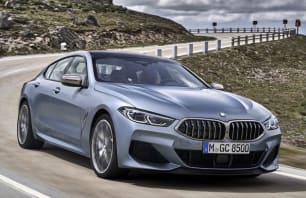I recall a Mitsubishi designer telling me, once upon a time, that he dreamed of making ‘a big car on the outside with a very small interior’. Maybe he made the jump to BMW, because that’s pretty much the 8 Series Gran Coupe.
There aren’t many other vehicles on the market, of this size, that offer less space inside. The boot capacity, for instance, is just 440 litres. Competitors like the Audi A7 (535L) and Mercedes CLS (520L) easily outdo it - but at least this car has more boot than the Panamera (405L), though the BMW is a smidge bigger. The cargo space is large enough for a couple of overnight suitcases, but you’re hardly going to fit a family of four’s luggage for a week away.
And while we’re in the “not quite what you’d expect” column, the back seat space is hardly commodious. There’s enough space for me, at 182cm, to sit behind my own driving position, but not without wishing for a bit more toeroom, headroom and knee space.
The big centre console section eats into the space in the rear, justifying the brand’s “4+1” seating claim, and unpleasantly it has a hard plastic finish to rest your leg against. Getting in and out of the second row isn’t easy for bigger people, and it’s quite a squat down into the rear seat - it really has taken inspiration from its squashy-back-seated predecessor in that regard.
If you have smaller rear-seat occupants, however, there will be catered for with dual ISOFIX and three top-tether points, plus there are air vents with climate controls (quad zone in total), and two USB-C ports as well. There are sun-blinds on the rear windows, too, which is a plus, and there is a pair of cup holders in the fold-down armrest, and map pockets in the seat backs, too. The door pockets are near-useless, though.
The front seats score better practicality, with bottle holders in the doors, bigger and sturdier cup holders, a covered centre storage bin between the seats with a USB-C port, and a wireless phone charger (Qi) with standard USB port in front of the gear selector.
Above that is the weird, very out-of-place quick buttons (1-8) that BMW could easily do away with, and further up are the controls for the climate control (thankfully with hard buttons for fan speed and temperature), and above that is the media screen, a familiar looking 10.25-inch touch display running BMW OS 7.0.
The screen is quick and crisp, and is backed up by the rotary controller and buttons on in the centre console area. There’s wireless Apple CarPlay (now at no cost for three years), as well as a built-in SIM card for 4G data and access to the BMW Online news and weather stations, accessed through the screen.
It’s all pretty easy to use, and the sound system is excellent - the standard setup consists of 16 speakers, with DAB+ digital radio, Bluetooth and USB plus the smartphone mirroring tech, provided you don’t have an Android device, as Android Auto is still missing from BMW’s range.
It’s a nice cabin, but I couldn’t help but thinking that I’d want a little more differentiation from the lesser models in the range if I was spending this much. Especially considering the optional cost of the interior trim fitted to our test car - see below for more detail.

